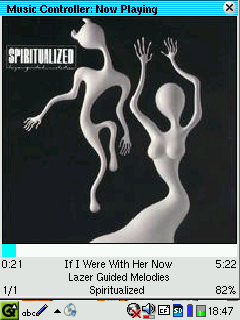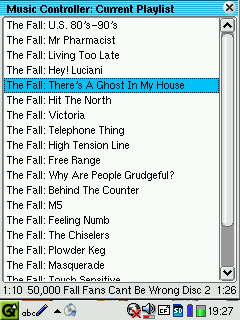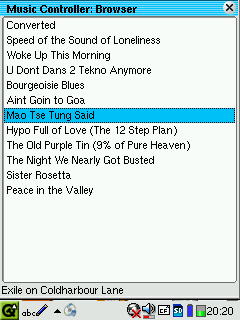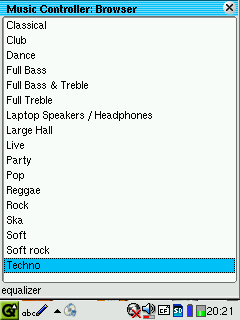

 |
 |
The server supports multiple clients and propagates state changes initiated by one to all of them. This allows, for instance, a TV-out signal to display the same information as the remote, presenting interesting possibilities for argument over choice of music.
Future work
A MIDP client is planned, to allow the server to be controlled by a JSR82-enabled phone, e.g., the Nokia 6600.
Serving Music
Audio is played back through the Java Sound API,javax.sound.sampled. The Service Provider Interface is
Javazoom's MP3SPI (or VorbisSPI)
and decoding is by its JLayer decoder.
Information on the currently playing track is displayed on an LCD screen (currently a Palm V running PalmORB) via LCDProc.
When a track has been played, audioscrobbler is notified of the fact, via a custom client interface, jscrobbler.
Hibernate controls access to the metadata generated by the player which is stored in the MySQL database. This currently comprises four tables which record: playlists, individual tracks, a cross-table mapping tracks to playlists, and a list of tracks which have been played but not submitted to audioscrobbler.
Spring abstracts the Hibernate O/R mapping and provides overall application configuration via dependency injection. (Retrofitting Spring to this application was remarkably easy: the bulk of the work was done in less than a day.)
Future work
While the architecture of the server has necessarily evolved, due to the time constraints on this project, it is moving towards an information bus down which events are propagated and whose observers are either local (e.g., the LCD display driver) or remote (the remote control). This is facilitated by the IoC container.
The most pressing current need is for a comprehensive testsuite in order to preserve developer-sanity. (The shortness of time available for this project does not allow sufficiently-thorough manual testing after each modification.)
Server Management
The management webapp supports the functionality which would be difficult to provide through the elementary Remote Control interface, which is, after all, intended to be used in a more casual environment. Currently this functionality comprises:- Genre maintenance: creating, renaming and moving artists between genres.
- Uploading cover art: if the Amazon query was unable to decide which of the results was the correct one, the user must be able to do so manually.
- Setting server parameters: some parameters, such as username and password for Audioscrobbler, must be settable on a per-user basis.
- Naming and editing playlists: currently every track played is amalgamated into a playlist, using elementary heuristics to decide playlist contents and boundaries. Obviously all playlists do not need to be kept nor are their contents perfect first time.
- Editing ID3 tags, using Scilla.
- Identifying disks unknown by freedb.org: allow playback of the ripped WAV files and creation of the metadata information.
The technology used by the webapp is fairly standard for a J2EE front-end: Struts is used for the view and controller parts, and Tomcat as the servlet container. Some use is made of the Commons Beanutils API, because it was already available from Hibernate.
Other, system-management, concerns are addressed by Webmin.
